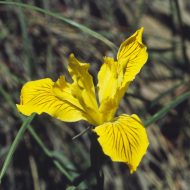Golden iris – Iris innominata
Range: An inland iris, seldom found within sight of the ocean; locally abundant at higher elevations in the Klamath mountains of southwestern Oregon, 1300 to 6600 ft (400-2,000 m) elevation.
Original collection: Rogue River area, Curry County, Oregon 1929.
Name: By Louis Forniquet Henderson, 1930, calling attention to this previously known but until then unnamed (innominatus) iris.

Key identifying features:
- Floral tube slender, funnel-shaped at top, medium length (around ¾ inch).
- Spathes short, broad and closed around ovary.
- Ovary rounded in cross section.
- Flower parts rather broad and rounded.
- Numerous flowers on each mature clump.
- Leaves very slender, grass-like, dark glossy green above, lighter matte below, long-lasting.
- Mature plants form dense, compact evergreen tussocks.
Flower color: Typically pale yellow to bright golden-yellow, with darker veins; other colors include white, grades of pale cream-yellow to orange.
Habitat: Woodland settings, preferring open locations with well-drained soil; in fir/pine forests; sunny meadows or other well-exposed sites on lightly shaded slopes.
Comments: This is one of the most attractive wild PCIs, often used for hybridizing because of its abundant golden flowers, clump-forming habit with dense, compact evergreen leaf growth.
One typical plant seen along Reuben Road in southern Oregon covered just one square foot of ground, and had 68 bright golden-yellow flowers all open at the same time.
Garden breeders often cross I. innominata with I. douglasiana. Many of the plants labeled “Iris innominata” in nurseries are actually hybrids.

